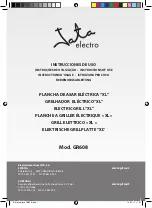
Care of Stainless Steel
Stainless Steel is widely used for
catering and residential kitchen
equipment because of its strength, its
ability to resist corrosion and its ease
of cleaning. In fact, stainless steel
ranks alongside glass and new china
in terms of "ease of cleaning" and in
percentage removal of bacteria during
washing up. As a result of these
virtues, the metal is often taken for
granted and it is assumed that no
problems will arise during its usage.
However, some care is required to
ensure that the stainless steel can live
up to this reputation.
DAY TO DAY CARE
To maintain the original appearance of
your SOLAIRE INFRARED Grill, a regular
cleaning routine should be carried out
using the following guidelines:
1. After use, following the safety pre-
cautions detailed on Page 2, wipe the
Grill with a soft damp soapy cloth and
rinse with clean water, preferably
warm/hot water. This should remove
most substances encountered during
the grilling process
2. For more tenacious deposits, including
oil, grease and water-borne deposits,
use a multi purpose cream cleanser
and apply with a soft damp cloth.
Rinsing with fresh water, as above,
should follow this.
3. For really stubborn dirt or burnt on
grease, a nylon-scouring pad may be
used in conjunction with the cream
cleanser. On no account should "wire
wool" pads be used unless they are
made of stainless steel.
4. Harsh abrasives and scouring
materials should not be used for
cleaning stainless steel as they will
leave scratch marks in the surface and
damage the appearance of the Grill.
Likewise do not use wire brushes,
scrapers or contaminated scouring pads.
5. Your SOLAIRE INFRARED Grill has
a directional polished grain, any
cleaning with abrasives should be
carried out along this grain and not
across it.
6. After use, always remove wet
cleaning aids (such as cloths, pads,
containers) from the surface, to avoid
formation of water marks/stains.
7. If required, dry the Grill after use
with a soft dry cloth or towel.
If the preceding guidelines are
adhered to, your SOLAIRE INFRARED
Stainless Steel Grill should offer excellent
life and should live up to its reputation
of being "stainless".
Neglect of this practice, however, can
lead to deterioration of the surface
and, in some extreme cases, corrosion
of the steel itself. The two most common
types of corrosion that may be
encountered, particularly on stainless
steel, are rust marks and pitting of the
surface.
RUST MARKS
When this type of staining occurs it is
unlikely that rusting of the stainless
steel itself causes the marks. Similar
marks can be found with both porcelain
and plastic sinks. The rust marks are
more likely to be the result of small
particles of "ordinary-steel" which
have become attached to the surface;
these have subsequently rusted in the
damp environment. The most common
source of such particles is from "wire-
wool" scouring pads, but contamination
may also occur from carbon steel utensils
and old cast iron water supply pipes.
These brown marks are only superficial
stains, which will not harm the Grill;
they should be removable using a soft
damp cloth and a multi-purpose cream
cleanser. Occasionally, it may be nec-
essary to resort to a proprietary stain-
less steel cleanser, to return the surface
of the Grill to its original condition.
To avoid re-occurrence of any "rust-
staining" it is essential that the source
of the contamination be eliminated.
PITTING
Another form of corrosion, which
occasionally occurs in stainless steel,
is pitting of the surface. The reason for
this corrosive attack can usually be
attributed to certain household products,
for example:
Bleaches
Most common domestic bleaches &
sterilizing solutions contain chlorine in
the form of sodium hypochlorite. If
used in concentrated form, bleaches
can attack the stainless steel, causing
pitting of the surface. They should
always be used to the strengths
prescribed by the manufacturer and
should be thoroughly rinsed off with
clean water immediately after use. All
cleaning agents containing hypochlorites
are unsuitable for long term contact
with stainless steel and, even when
used in the highly diluted form, they can
give pitting under certain conditions.
Foodstuffs
In general stainless steel is fully resistant
to all foodstuffs in common use. Only
in isolated cases, such as when con-
centrated salt and vinegar mixtures are
allowed to remain in contact with the
steel for a long period, can any sur-
face marking result.
Page 15
Summary of Contents for Solaire
Page 1: ......
Page 25: ...Parts List Drawing Page 23 1 2 3 4 5 5 6 7 8 9 10 11 12 13 14 15 16 17 18 ...
Page 26: ...Notes Page 24 ...












































